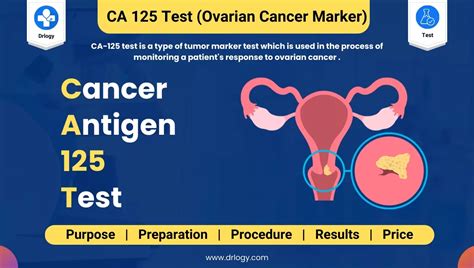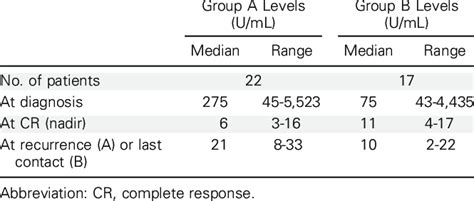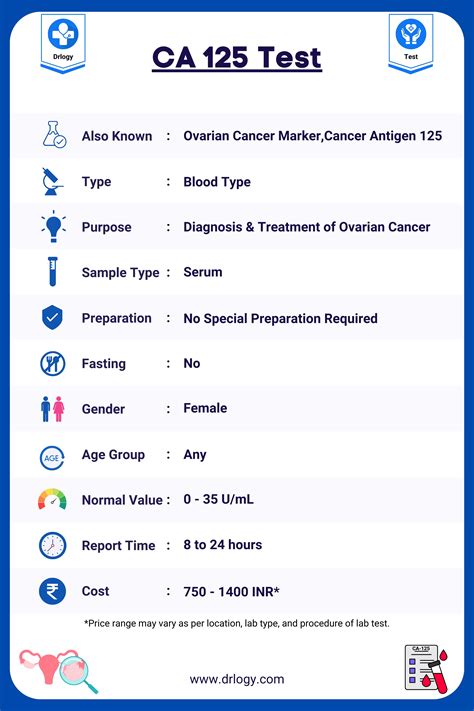Intro
Discover Cancer Antigen 125, a tumor marker for ovarian cancer diagnosis, linked to epithelial ovarian cancer, mucinous ovarian cancer, and borderline ovarian tumors, aiding in monitoring treatment and recurrence.
Cancer antigen 125, commonly referred to as CA-125, is a protein that is often found on the surface of ovarian cancer cells, as well as in some normal tissues. The CA-125 test is a blood test that measures the level of this protein in the blood, and it is commonly used as a marker for ovarian cancer. However, elevated levels of CA-125 can also be found in people with other types of cancer, as well as in those with non-cancerous conditions such as endometriosis, pregnancy, and pelvic inflammatory disease.
The importance of understanding CA-125 lies in its potential to aid in the early detection and monitoring of ovarian cancer, which is one of the most deadly types of cancer in women. Ovarian cancer is often referred to as a "silent killer" because it can be difficult to detect in its early stages, and symptoms may not appear until the disease has spread to other parts of the body. By monitoring CA-125 levels, doctors may be able to detect ovarian cancer at an earlier stage, when it is more treatable. However, it is essential to note that the CA-125 test is not foolproof and can have false-positive and false-negative results, which is why it should be used in conjunction with other diagnostic tools.
The role of CA-125 in cancer diagnosis and treatment is complex and multifaceted. On one hand, it can be a useful tool for monitoring the effectiveness of cancer treatment and detecting recurrence. On the other hand, it is not a definitive diagnostic tool and should not be relied upon as the sole means of diagnosis. As research continues to uncover the intricacies of CA-125 and its relationship to cancer, it is becoming increasingly clear that a comprehensive approach to diagnosis and treatment is essential for improving patient outcomes.
What is CA-125?

How is CA-125 used in cancer diagnosis?
The CA-125 test is often used in conjunction with other diagnostic tools, such as ultrasound and biopsy, to help diagnose ovarian cancer. It can also be used to monitor the effectiveness of cancer treatment and detect recurrence. However, the test is not perfect, and false-positive and false-negative results can occur. For example, some people with non-cancerous conditions such as endometriosis or pelvic inflammatory disease may have elevated CA-125 levels, while others with ovarian cancer may have normal or only slightly elevated levels.Benefits and Limitations of CA-125 Testing

What are the risks and side effects of CA-125 testing?
The risks and side effects of CA-125 testing are generally minimal. The test involves a simple blood draw, which may cause some discomfort or bruising at the injection site. However, some people may experience more significant side effects, such as dizziness or fainting, after the test. Additionally, false-positive or false-negative results can cause unnecessary anxiety or delay in diagnosis.CA-125 Levels and Ovarian Cancer Stages

How are CA-125 levels interpreted?
CA-125 levels are typically interpreted in conjunction with other diagnostic tools, such as ultrasound and biopsy. The results of the test are usually reported as a number, with higher numbers indicating higher levels of CA-125 in the blood. The normal range for CA-125 levels is typically considered to be below 35 units per milliliter (U/mL), although this can vary depending on the laboratory and the individual.CA-125 and Other Cancers

What are the implications of CA-125 in other cancers?
The implications of CA-125 in other cancers are complex and multifaceted. While elevated CA-125 levels can indicate the presence of cancer, they are not specific to ovarian cancer and can be found in people with other types of cancer. Additionally, CA-125 levels can be influenced by a range of factors, including the type and stage of cancer, as well as the individual's overall health.Future Directions for CA-125 Research

What are the potential applications of CA-125 research?
The potential applications of CA-125 research are vast and varied. By improving our understanding of CA-125 and its role in cancer, scientists may be able to develop new diagnostic and therapeutic tools for ovarian cancer and other types of cancer. Additionally, research into CA-125 may lead to a better understanding of the underlying biology of cancer, which could have implications for the development of new treatments and therapies.What is the normal range for CA-125 levels?
+The normal range for CA-125 levels is typically considered to be below 35 units per milliliter (U/mL), although this can vary depending on the laboratory and the individual.
Can CA-125 be used as a screening test for ovarian cancer?
+While CA-125 can be used as a diagnostic tool for ovarian cancer, it is not currently recommended as a screening test for the general population. This is because the test is not sensitive or specific enough to detect all cases of ovarian cancer, and it can have false-positive and false-negative results.
What are the risks and side effects of CA-125 testing?
+The risks and side effects of CA-125 testing are generally minimal. The test involves a simple blood draw, which may cause some discomfort or bruising at the injection site. However, some people may experience more significant side effects, such as dizziness or fainting, after the test.
In conclusion, CA-125 is a complex and multifaceted protein that plays a crucial role in the diagnosis and monitoring of ovarian cancer. While it has its limitations and potential drawbacks, it remains a valuable tool in the fight against this devastating disease. By continuing to research and develop new diagnostic and therapeutic tools, scientists may be able to improve patient outcomes and save lives. We invite you to share your thoughts and experiences with CA-125 testing, and to explore the many resources available for those affected by ovarian cancer. Together, we can work towards a brighter future for all those touched by this disease.
